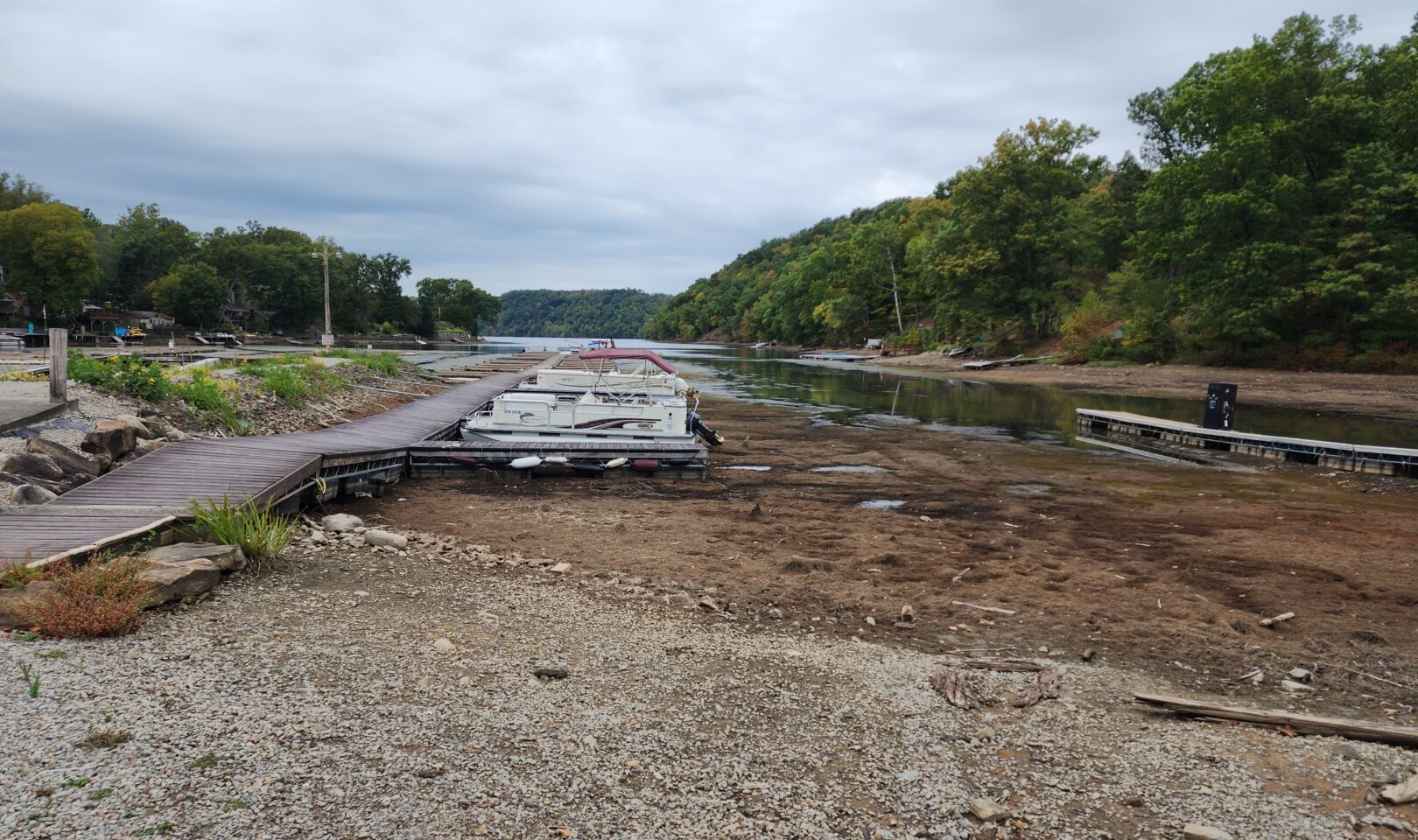The effects of the ongoing drought are apparent around Cheat Lake. Marinas are largely empty. Boats are stranded here and there on what are now mud flats. Related in part to the low lake levels, vast swaths of hydrilla cover portions of the lake surface.
Lake Lynn Generation has notified the Federal Energy Regulatory Commission twice about the low levels, first on Sept. 13 and again on Sept. 20.

The company’s license requires it to maintain lake levels between 868 and 870 feet, while releasing into the Cheat River a minimum flow of 212 cubic feet per second (cfs), or inflow to the lake, whichever is less; with an absolute minimum of 100 cfs to the river, regardless of inflow to the lake.
In its most recent filing, Lake Lynn reminded FERC that ongoing deviation from the minimum lake level began on Sept. 7. From Sept. 7-13, the lowest level reached 866.9 feet. From Sept. 13-20, the level dipped to 865.3 feet.
“No adverse environmental impacts to the aquatic ecosystem were observed or reported,” it said, “Recreational boating in shallow areas of the reservoir Cheat Lake is being impacted by the lower elevation.”

The company continues to operate the dam spillway to maintain the minimum 100 cfs flow into the river and maintain the required dissolved oxygen levels, it said.
Based on current weather forecasts, Lake Lynn told FERC that it anticipates the severe drought conditions to continue and reservoir elevation to decrease about 2 inches per day until meaningful precipitation falls in the watershed.
Boaters can get periodic updates on lake conditions at its Cheat Lake Today public website: Recreation – Cheat Lake Today. The company said it has also installed signage and keeps key stakeholder groups and marinas informed.
On Sept. 11, Lake Lynn Generation withdrew its request to FERC for a temporary variance on its license requirement to maintain the minimum Cheat Lake level at 868 feet, in order to lower it by 3 feet to increase the required dissolved oxygen level.

That proposal met widespread public opposition and Lake Lynn withdrew its request after West Virginia’s Department of Environmental Protection and Division of Natural Resources withdrew prior OK’s and FERC requested more information on alternative options from Lake Lynn.
A Cheat Lake resident stated in a Sept. 17 complaint to FERC the drought’s effects on the lake somewhat more dramatically than Lake Lynn had put it: “For the last week, boaters, business owners and marinas have been in an emergency situation frantically trying to remove boats and docks from the lake. Docks are being destroyed and boats are stuck on the lake bed. Many many boats remain on the lake in jeopardy.”
A Sept. 4 letter to FERC complained about the hydrilla growth, which in now worse than it was then. That resident said, “Its thick mats of vegetation clog boat props and boat coolant intakes causing boat motors to overheat, while building a toxic environment that threatens our newly restored fish population. Due to the low lake levels this summer, partially due to the ongoing drought and partially due to lake level mismanagement by Eagle Creek, the Hydrilla has grown exponentially.”
Alleged lake level mismanagement is a common theme among the letters filed with FERC. The Sept. 17 letter said the community believes the company has deliberately lower lake levels without a proper variance to its license.
The Biafora family of businesses has been vocal in its opposition to the now-withdrawn proposal to lower the lake and in echoing the accusations of mismanagement.
David Biafora told The Dominion Post on Tuesday, “It’s affecting everybody’s business.”
He is among those who believe Lake Lynn is violating its permit while attributing the lower levels to the drought. “Yes, we have a drought, but they have opened the dam to make money. … They could just keep the dam closed,” he said.
He noted, “Our marina is fine. … Our ramp goes out 50-60 feet.” And boaters can access the lake there. But the lake is shallow and the island near Edgewater is appearing.
The company has previously said its FERC license does not prioritize any of the flow requirements, and “it is difficult, if not impossible, for Lake Lynn to comply with the competing requirements during extremely hot and dry periods.” Because it prioritizes its license requirements over generating power, it hasn’t produced electricity since July 5, except for a few brief instances.
FERC is reviewing Lake Lynn Generation’s application to renew its Lake Lynn Hydroelectric Project license, which expires Nov. 30. As part of the application, Lake Lynn Generation/Eagle Creek Renewable Energy propose to remove 243.8 acres surrounding Cheat Lake from federal protection. The company has said it has no plans to sell the land, though public distrust remains, reflected in dozens of public comments submitted to FERC.
Lake Lynn told FERC again in its Sept. 20 filing that to help remedy the competing license requirements in the future, it has proposed, in its Final License Application, to develop an Operation Plan that will include standard operating procedures to be implemented during periods of low inflow and low dissolved oxygen, “which will document the prioritization of license requirements and how Lake Lynn will comply with the operational requirements of the license.”
Email: dbeard@dominionpost.com


